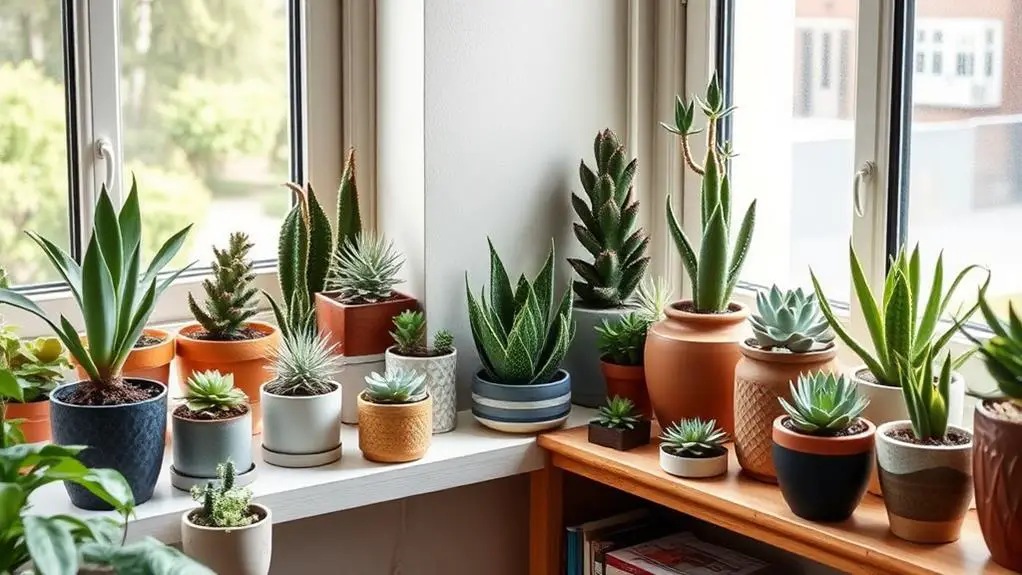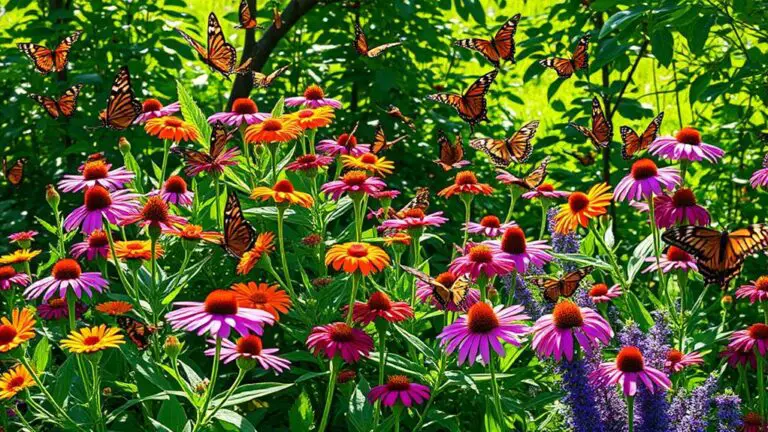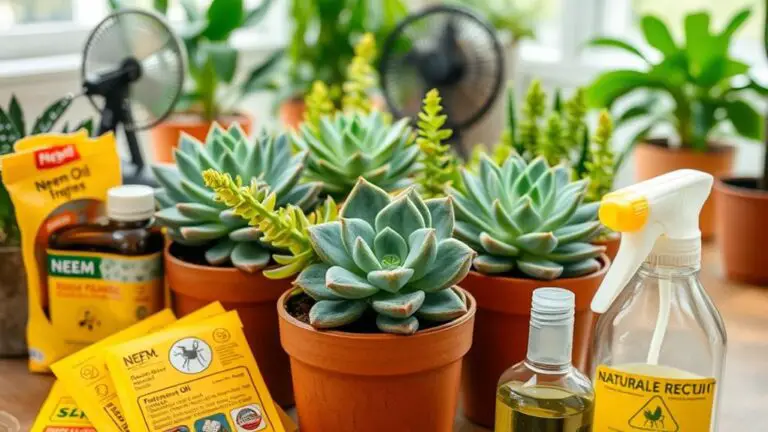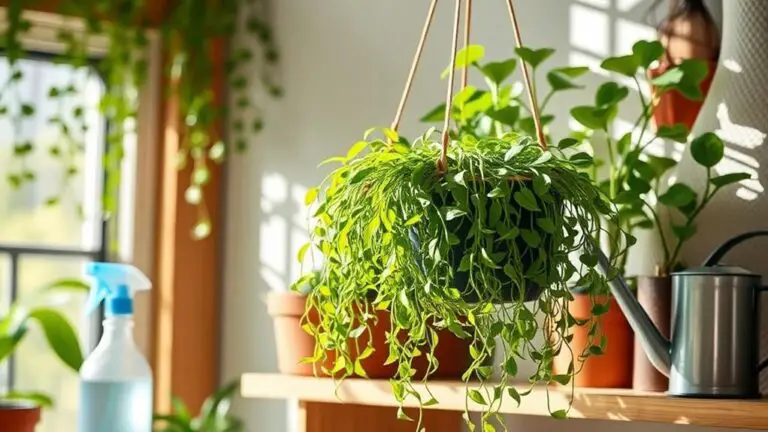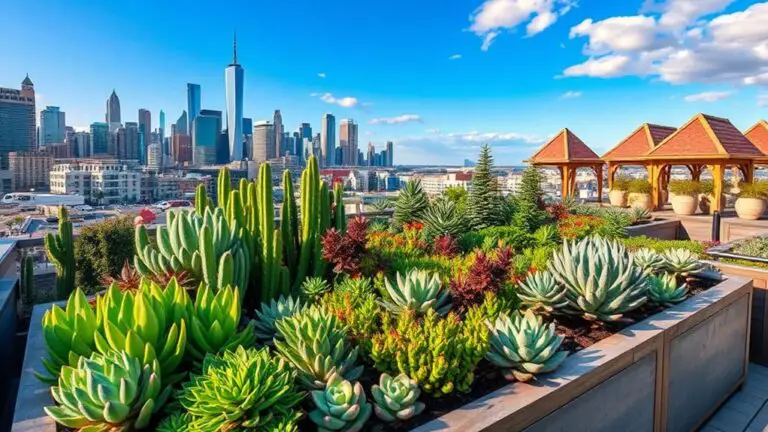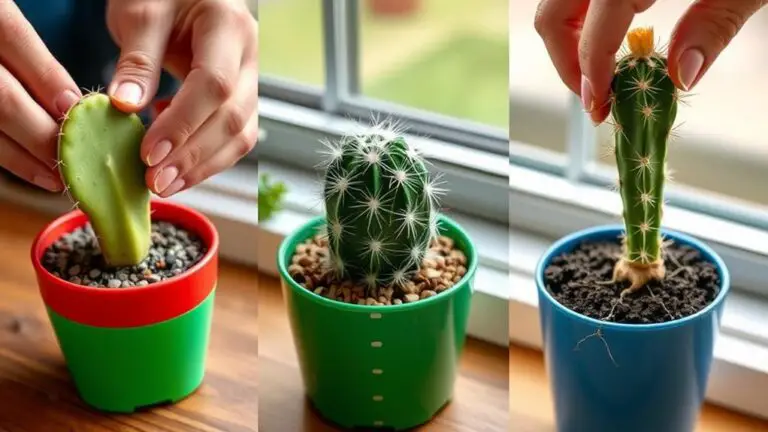7 Easy Succulents for Anyone to Grow Inside
If you're looking to bring some low-maintenance greenery into your home, succulents are a fantastic option. They're not just easy to care for, but they also come in a variety of shapes and sizes that can complement any interior decor. From the trailing Burro's Tail to the air-purifying Snake Plant, there's a succulent for everyone. You'll find that each one has unique qualities, whether it's the festive blooms of the Christmas Cactus or the healing properties of Aloe Vera. Curious about what makes these plants so special and easy to grow? Let's explore further.
Burro's Tail
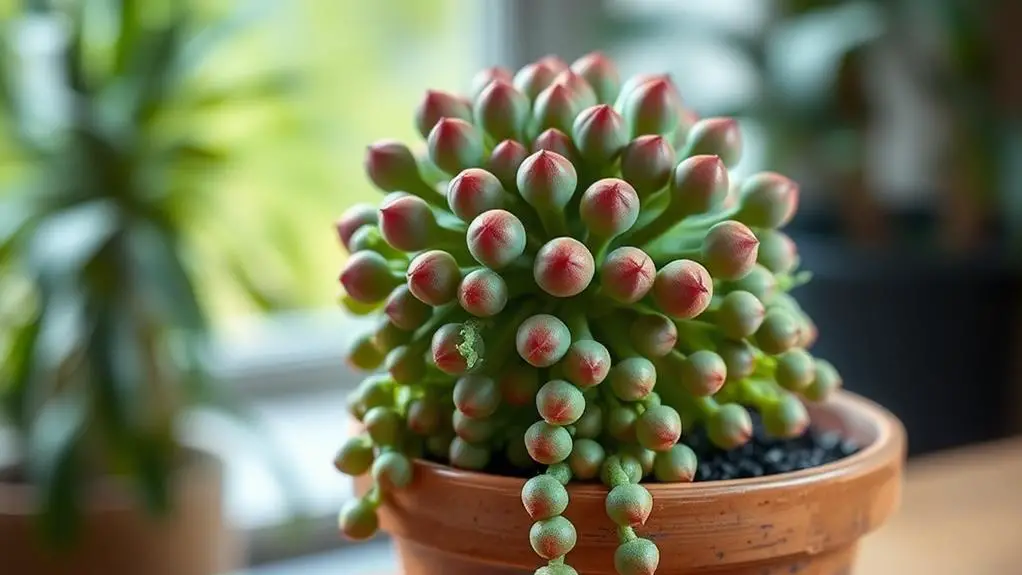
When it comes to adding a unique touch to your indoor space, Burro's Tail (Sedum morganianum) is a fantastic option. This trailing succulent can grow stems up to 3 feet long, making it perfect for hanging baskets or elevated planters. Its fragile, teardrop-shaped gray-green leaves add a lovely texture to any room.
As an indoor succulent, Burro's Tail thrives in bright light. Place it near a sunny window where it can soak up plenty of indirect sunlight.
It's crucial to use well-draining soil for your Burro's Tail. This type of soil dries out completely between waterings, which helps prevent root rot. Overwatering can cause leaf drop and rot, so monitor the moisture levels carefully. Only water when the soil feels dry to the touch.
Burro's Tail is relatively low-maintenance, making it ideal for busy individuals or those new to gardening. It requires infrequent watering, which means you don't have to fuss over it constantly.
Just remember, a bit of neglect is actually beneficial for this plant. By following these simple care tips, you'll keep your Burro's Tail healthy and thriving, adding beauty to your indoor space.
Christmas Cactus

While Burro's Tail is a fantastic option for adding trailing greenery to your indoor space, the Christmas Cactus (Schlumbergera) offers a different kind of charm. Unlike typical spiky cacti, the Christmas Cactus has flat, segmented stems, making it safe for homes with children and pets.
This unique succulent thrives in bright light but needs more moisture. Keep the soil slightly moist, especially during its growing season.
One of the most delightful aspects of the Christmas Cactus is its stunning pink flowers. These bloom in winter, bringing vibrant color to your home during the holiday season. To encourage these blooms, expose your cactus to cooler temperatures (around 50-60°F) and reduce watering for about six weeks before the flowering period. This helps trigger the plant's blooming cycle.
If you want to multiply your Christmas Cactus, it's easy to propagate through stem cuttings. Simply take a few segments and root them in well-draining soil.
With a little care, these cuttings will grow into new plants, allowing you to share the beauty of your Christmas Cactus with friends and family. So, give this charming succulent a try and enjoy its delightful winter blooms!
Hens-and-Chicks
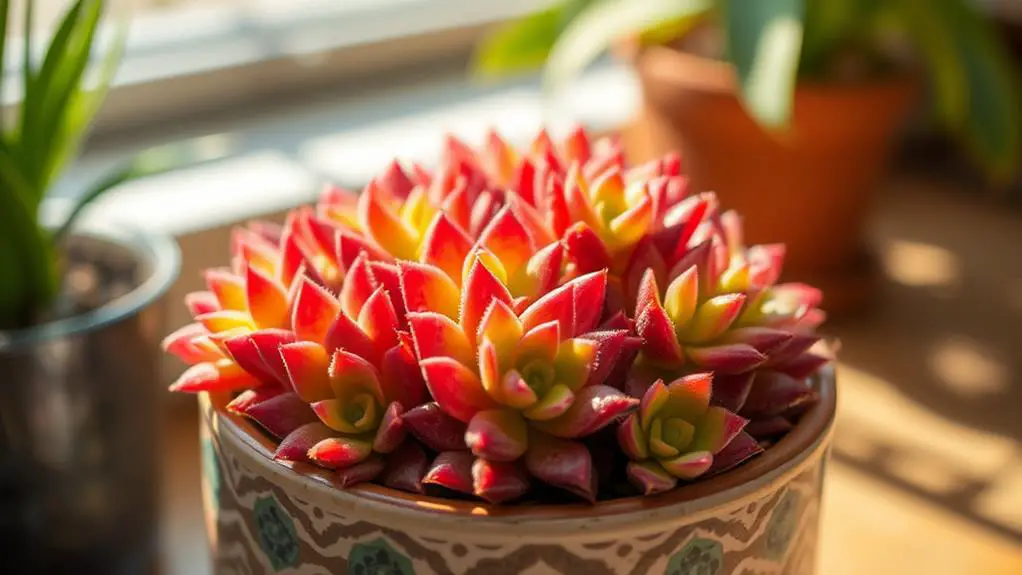
Hens-and-Chicks (Sempervivum) are some of the most resilient and beginner-friendly succulents you can grow indoors. These hardy plants are perfect for adding charm to your indoor decor. They thrive in various conditions and produce "chicks" or offsets around the main "hen," making propagation easy and fun.
To keep your hens-and-chicks healthy, place them in bright light and use well-draining soil. Only water them when the soil is dry to the touch to avoid root rot. They're low-maintenance, so they don't need much attention, making them great for busy people or newbies to gardening. Plus, they can withstand cold temperatures, though you should protect them from frost if you decide to move them outside.
Here's a quick guide to help you care for your hens-and-chicks:
| Factor | Requirement | Tip |
|---|---|---|
| Light | Bright light | Place near a sunny window |
| Soil | Well-draining soil | Use cactus or succulent potting mix |
| Watering | When soil is dry | Check by touching the soil |
| Temperature | Hardy, avoid frost | Keep indoors during cold months |
| Propagation | Offsets (chicks) | Separate and replant chicks easily |
Jade Plant
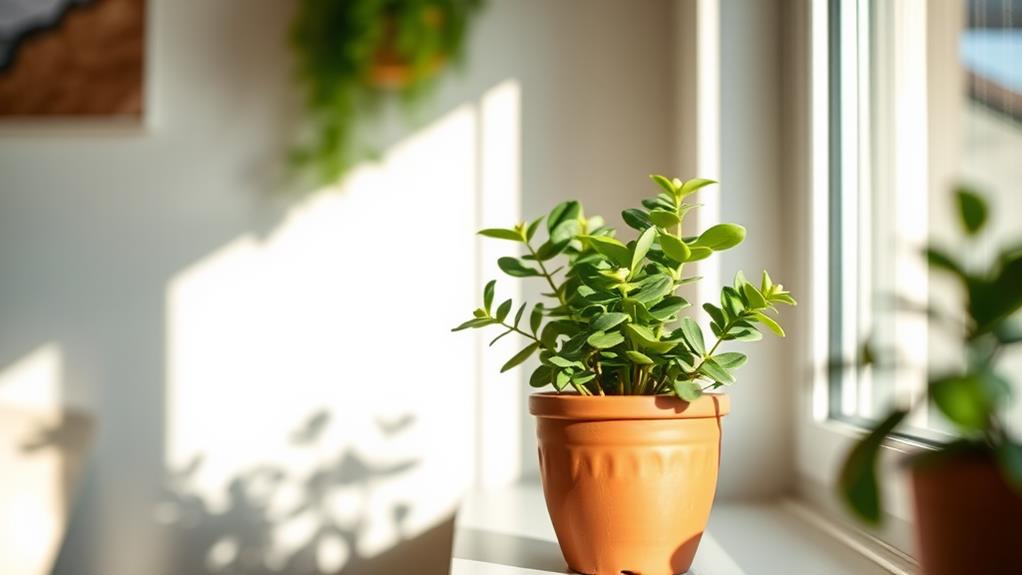
Let's talk about the Jade Plant, which is perfect for adding a touch of green to your home.
This succulent loves bright, indirect sunlight and needs well-draining soil to thrive.
Make sure you let the soil dry out completely between waterings to keep it healthy and prevent root rot.
Light Requirements
To guarantee your Jade Plant (Crassula ovata) thrives indoors, it's crucial to provide bright, indirect sunlight for at least six hours a day. This type of light enhances their growth and guarantees their green leaves stay vibrant.
Although these succulents can tolerate some direct sunlight, too much can cause leaf burn, leading to brown spots or shriveling.
Here are four tips to help you meet your Jade Plant's light requirements:
- Ideal Placement: Position your Jade Plant near a south or west-facing window where it can get plenty of bright light without being scorched.
- Indirect Light: Confirm the light is indirect. Direct sunlight for long periods can be harmful, while indirect light keeps your plant happy and healthy.
- Watch for Stretching: If your Jade Plant starts to look leggy and elongated, it's probably not getting enough light. This stretching means it's trying to move toward the light source.
- Seasonal Adjustments: During shorter winter days, you might need to move your plant closer to the window or provide supplemental light to maintain its growing conditions.
Watering Needs
Watering your Jade Plant properly is key to its health and longevity. The right approach guarantees your plant stays vibrant and avoids common issues like root rot.
Jade Plants thrive on the soak and dry method, which means you should let the soil completely dry out between waterings. This method supports the plant's natural growth cycle and helps prevent moisture-related problems.
During the growing season, which is spring and summer, you should water your Jade Plant approximately every 2-3 weeks. Keep an eye on environmental factors like humidity and temperature, and adjust the frequency as needed.
In winter, when the plant enters dormancy, reduce watering to once a month or less, as the plant needs considerably less moisture during this period.
Always water at the base of the plant to avoid wetting the leaves. Wet leaves can lead to leaf rot and fungal issues.
Make sure your Jade Plant is in well-draining soil and a pot with drainage holes. These elements help control moisture levels effectively, preventing excess water retention and the risk of root rot.
With these guidelines, you'll guarantee your Jade Plant remains healthy and happy indoors.
Growth and Maintenance**
How do you guarantee your Jade Plant thrives indoors? Start by giving it the right environment. Jade Plants, which are succulent plants, need bright, indirect sunlight for at least 6 hours a day to keep their thick leaves healthy and vibrant.
Here's a simple guide to assure your Jade Plant flourishes:
- Light: Place your Jade Plant in a spot where it gets bright light but not direct sunlight. A south-facing window works well.
- Soil: Use a well-draining potting mix, specifically designed for cacti or succulent plants. This prevents root rot by allowing excess moisture to escape.
- Watering: Only water when the top inch of soil is dry. Typically, this means watering every 2-3 weeks, but always check the soil first to avoid overwatering.
- Propagation: If you want more Jade Plants, you can easily propagate them through leaf cuttings or offsets. Just place the cuttings in soil and wait for new roots to grow.
Jade Plants are drought-resistant and relatively low-maintenance. With the right care, they can grow up to 3 to 6 feet tall.
Following these tips will help you keep your Jade Plant healthy and thriving indoors.
Aloe Vera
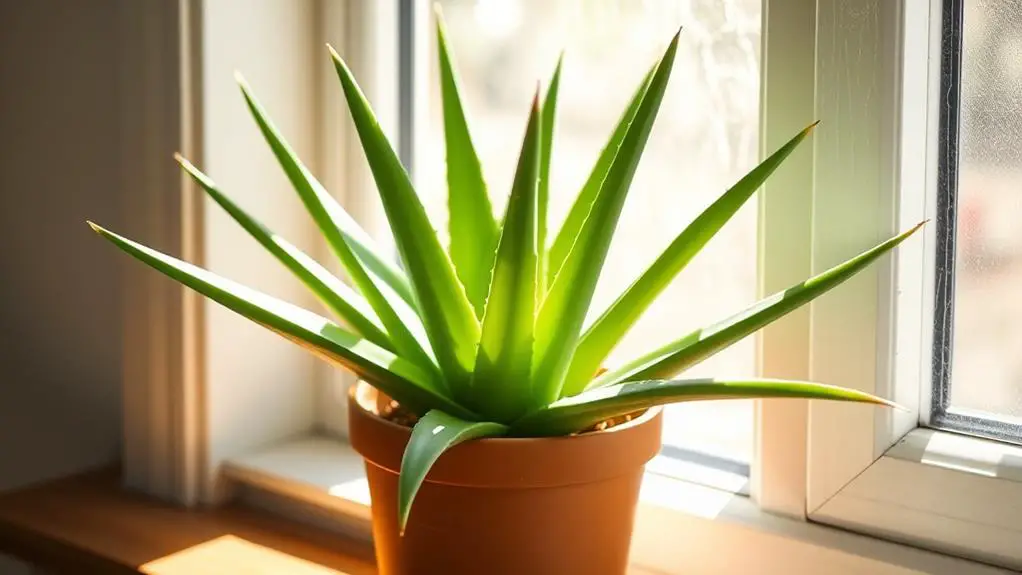
Aloe Vera is a fantastic choice for your indoor garden, offering both beauty and practical benefits.
It thrives in bright light and needs a well-draining potting mix to prevent root rot, so place it near a sunny window and use the right soil.
Its healing sap is great for treating minor burns and skin irritations, making it a handy plant to have around the house.
Healing Sap Benefits
Renowned for its healing properties, Aloe Vera (Aloe barbadensis miller) boasts a sap rich in beneficial compounds like aloin and aloe-emodin. This healing sap has incredible anti-inflammatory and antimicrobial properties, making it a must-have in your home.
Aloe Vera's gel-like substance is effective for:
- Soothing burns and skin irritations: Apply it directly to burns, cuts, or rashes to promote faster healing and reduce inflammation.
- Hydrating properties: Its moisturizing sap is great for hydrating skin, making it a popular ingredient in cosmetic products.
- Digestive aid: When consumed in moderation, Aloe Vera can help with digestion, acting as a natural laxative and alleviating symptoms of irritable bowel syndrome (IBS).
- Vitamins and minerals: The sap is packed with essential vitamins, minerals, and antioxidants, supporting overall health.
Light and Water Needs
Understanding the light and water needs of Aloe Vera is key to its thriving indoors. Aloe Vera loves bright, indirect sunlight. Aim to place it where it can get at least six hours of light daily. This guarantees it grows robustly and maintains its vibrant color. If it doesn't get enough light, it might become leggy and weak.
When it comes to watering, Aloe Vera prefers to dry out completely between waterings. You should water it every 2-3 weeks, but always check the soil first. If the soil feels dry to the touch, it's time to water. Overwatering can be a big problem, leading to root rot, which can be fatal for your Aloe Vera.
So, make certain the soil is entirely dry before you water again. Using a well-draining succulent mix is essential. This type of soil helps prevent moisture from lingering around the roots, reducing the risk of overwatering and root rot.
During winter, you might need to water less often due to lower light levels and cooler temperatures. By understanding these light and water needs, you'll help your Aloe Vera flourish indoors.
Potting and Soil Tips
Proper potting and soil choices are essential for healthy Aloe Vera growth indoors. Choosing the right potting mix and ensuring proper drainage are key steps to prevent water rot and keep your Aloe thriving.
- Select the Right Soil: Use a well-draining soil mix specifically formulated for succulents or cacti. This usually includes sand, perlite, or pumice to provide ideal aeration and drainage.
- Choose the Right Pot: Pick a pot with ample drainage holes. Terracotta or clay pots are perfect because they help the soil dry out faster, reducing the risk of water rot.
- Pick the Correct Container Size: Use a pot slightly larger than the Aloe Vera root ball. This prevents waterlogging while still providing enough space for growth. Smaller pots can help control moisture levels.
- Repot Regularly: Repot your Aloe Vera every 2-3 years or when it outgrows its container. This refreshes the soil nutrients and allows room for root expansion.
After potting, let the Aloe Vera acclimate for a week before watering. Then, use the soak and dry method—ensure the soil is completely dry before watering again. This helps prevent root rot and keeps your Aloe Vera healthy and happy.
Panda Plant
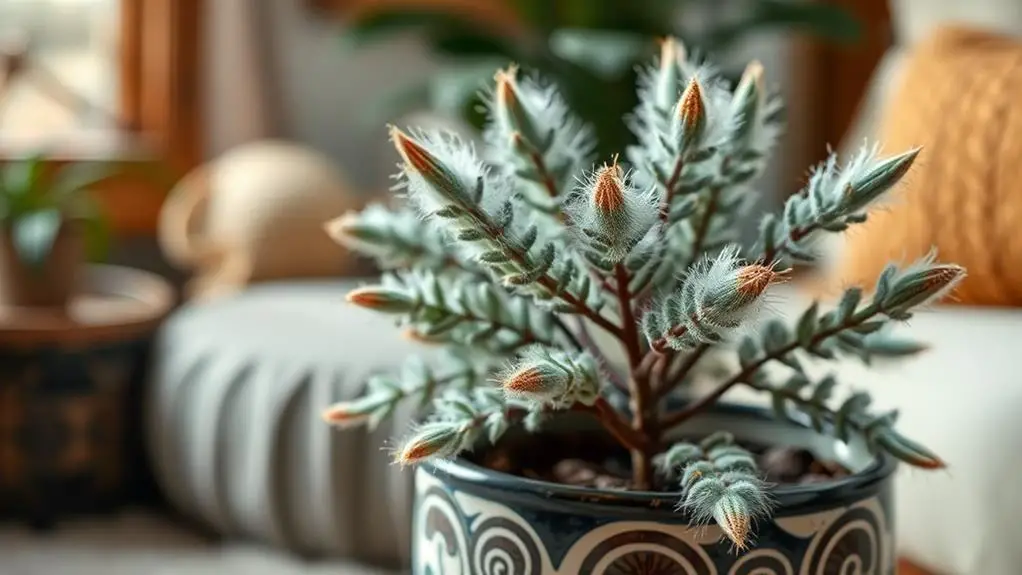
When it comes to adding a touch of greenery to your indoor space, the Panda Plant (Kalanchoe tomentosa) is an excellent choice. This succulent, known for its fuzzy leaves, can grow up to 2 feet tall and wide. The leaves are silvery with dark brown or black edges, making it a striking addition to any room.
The Panda Plant thrives in bright light, so place it near a sunny window to keep it happy. It's important to use a well-draining potting mix to prevent root rot. Overwatering is a common mistake, but don't worry—this plant prefers infrequent watering. Let the soil dry out completely between waterings to guarantee it stays healthy.
One of the best things about the Panda Plant is that it's low-maintenance. Its unique velvet-like leaves not only look good but also add a tactile element to your decor.
However, be aware that the Panda Plant is toxic to pets. Make sure to keep it out of reach of curious cats and dogs.
Snake Plant

The Snake Plant, also known as Sansevieria trifasciata, is a hardy succulent that's perfect for both beginners and busy individuals. You'll love how easy it's to care for.
Snake plants can survive weeks without water or light, making them incredibly low-maintenance. They typically grow around 2-3 feet tall indoors but can reach up to 12 feet in ideal conditions, adding architectural interest to your space.
Here's why Snake Plants are a great choice:
- Low Light Tolerance: While they thrive in indirect light, they can also tolerate low light, making them versatile for any room.
- Well-Draining Potting Mix: Use a well-draining potting mix to prevent root rot. It's essential to let the soil dry out completely between watering sessions.
- Infrequent Watering: Overwatering is a common mistake. These plants prefer infrequent watering, so you don't need to stress about a strict schedule.
- Improve Indoor Air Quality: Snake plants are known to filter toxins and release oxygen, enhancing the air quality in your home.
Frequently Asked Questions
What Is the Easiest Succulent to Grow Indoors?
The easiest succulent to grow indoors is the Snake Plant. You'll love its minimal maintenance and ability to thrive in low light. Just water it sparingly, and it will reward you with years of greenery.
What Is the Best Succulent for Beginners?
For beginners, try the Snake Plant. It's nearly indestructible, thrives on neglect, and only needs occasional watering. You'll find it perfect for a busy lifestyle, providing a hassle-free way to enjoy indoor greenery.
What Are the Most Low Maintenance Succulents?
You'll find Aloe Vera, Snake Plant, and Zebra Haworthia incredibly low-maintenance. They thrive with infrequent watering and varying light conditions. Just give them some attention now and then, and they'll flourish with minimal effort.
What Are the Easiest Succulents to Grow in Pots?
You'll find Donkey's Tail, String of Pearls, Aloe Vera, Jade Plant, and Ghost Plant are the easiest succulents to grow in pots. They require minimal care, thrive in different light conditions, and are perfect for beginners.
Conclusion
You've got this! Growing succulents like Burro's Tail, Christmas Cactus, and Hens-and-Chicks is a breeze, and they'll brighten up any room. Jade Plant and Aloe Vera add beauty and health benefits, while the Panda Plant and Snake Plant bring unique textures and cleaner air. With minimal care and some bright, indirect light, these succulents will thrive. So, immerse yourself in indoor gardening with confidence and watch your new plants flourish. Happy gardening!

